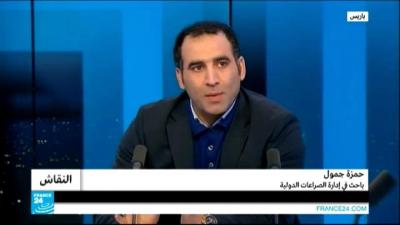Comment: The future of unarmed resistance in Palestine

CAGLIARI - The occupied Palestinian territories are witnessing growing individual armed operations known as the 'knife rebellion' - an expression of popular anger against what is seen as Israel’s Zionist policy. These events have renewed political and intellectual debate about the kind of resistance to be adopted in order to obtain Palestinian rights, either military resistance or non – violence.
Within this framework, the following questions are raised: is it possible to bring together military and non–violent resistance? Could non–violent resistance achieve Palestinian political and economic aims? In this article, I will discuss a recent academic publication co-authored by Dr. Marwan Darweish and Dr. Andrew Rigby from Coventry University, published by Pluto Press, entitled 'Popular Protest in Palestine - The History and Uncertain Future of Unarmed Resistance'.
The book provides an overview and analysis of the role and significance of unarmed civil (popular) resistance in the Palestinian national movement. Its main focus is on the contemporary popular resistance movement in the Occupied Palestinian Territories prefaced with a historical review of the thread of unarmed civil resistance that has run throughout the history of the Palestinian liberation struggle.
Several events in the past years have contributed to increasing mistrust between the Palestinians and their leaders. In fact the failure of the Oslo agreements, the useless "peace negotiations", the political division between Hamas and Fatah and the instability in the Arab countries have all pushed Palestinians to feel that they are alone in this battle.
On the other hand, however, the spontaneous nature of Palestinian Popular Resistance raises doubts about its effectiveness. This encourages us to illustrate the challenges facing the Palestinian popular resistance and then to introduce a scenario of hope.
Challenges facing Palestinian Popular Resistance
The challenges could be summarized as follows:
Weakness of the Popular resistance movement
The Palestinian Popular Resistance movement is characterized by a lack of effective strategy and inadequate coordination between the different socially and politically involved players. The absence of a strategy reduces the effectiveness of the popular resistance and trims down its ability to achieve the desired results.
In this context, Darwish and Rigby met several people in the Silwan community, noting that "a major challenge is the coordination of nonviolent activities. Some focus on the wall, others on checkpoints and other on settlements. There is no coordination like there was in the first intifada."
Mistrust between the leadership and the masses
The increased mistrust between the Palestinian and the leadership influences people’s involvement in non-violent resistance.
In this sense, the authors interviewed a group of people about the relation with the leadership, receiving replies like "I will not be a stepping-stone for people to climb upwards where I pay the price of participation and the leadership benefit and gather the fruits."
This mistrust between the leadership and the citizens threatens the most important element of success of any popular resistance and contributes to the growing phenomenon of individual initiatives, such as the 'knife rebellion' or unarmed protests such as individual demonstrations that are not considered efficient.
For instance Palestinian Minister Ziad Abu Ein case was assassinated by the Israeli army during a demonstration on 2014 against the Israeli occupation.
Towards a Scenario of Hope
The challenge for the Palestinians is to develop a unified resistance strategy, one that envisions a role for all, whatever their gender, political persuasion, location or age.
At the core of such a strategy must be a sustained commitment by political leaderships at all levels to build on the experience of the popular resistance of the post-second intifada period in order to create a situation where the occupation cannot continue as normal.
This means a situation in which the financial, political, diplomatic and economic costs become insupportable.
What would be the necessary preconditions for such a situation to take shape? What would be the key elements in such a scenario of hope? The authors present the following elements:
- The deepening of the process initiated in 2014 towards political reconciliation between Fatah and Hamas, followed by the establishment of a unity government.
- The recognition that a powerful popular resistance movement can act as a significant lever in such a diplomatic offensive and create a new power relationship.
- The use of all the factors of power provided by peaceful popular resistance.
- The development of popular resistance that impose significant economic, financial, social and diplomatic costs on Israel so that "normal service is no longer possible."
- The coordination with Israeli activists with a view to mobilizing a grass-roots international campaign to boycott the settlers’ production.
- The guarantee of the necessary financial support to ensure the continuity of the popular resistance.
- The aim of the resistance is the ending of the occupation.
The ongoing events in Palestine confirm that Palestinians are ready to participate in an effective popular resistance, what they need is a clear strategy developed by a unified political leadership.
Hamze Jammoul is a Lebanese researcher in International Relations. hz-ft


